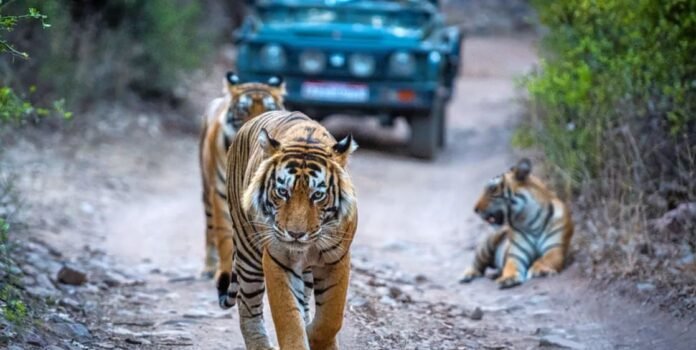India is home to some of the most diverse and rich wildlife reserves, but few can match the thrill of a Ranthambore Tiger Safari. Nestled in the heart of Rajasthan, Ranthambore National Park is one of the most sought-after destinations for wildlife enthusiasts, nature lovers, and photographers. Spread across 1,334 square kilometers, this former royal hunting ground now serves as a protected sanctuary for Bengal tigers, leopards, sloth bears, and a wide variety of flora and fauna. What makes Ranthambore stand out from other wildlife destinations in India is its unique landscape, high tiger density, and an unparalleled safari experience that brings visitors face-to-face with the majestic predators in their natural habitat.
The Unmatched Beauty of Ranthambore National Park
Unlike other wildlife sanctuaries that are densely forested, Ranthambore offers a mix of dry deciduous forests, open grasslands, rocky terrain, and ancient ruins that add to its dramatic charm. The park is dotted with several water bodies, including the famous Padam Talao and Rajbagh Lake, where animals frequently gather, offering perfect opportunities for breathtaking wildlife photography. The presence of the historic Ranthambore Fort, a UNESCO World Heritage Site, further enhances the park’s grandeur, making it a rare blend of history and wilderness.
Encounter the Royal Bengal Tigers in Their Natural Habitat
One of the primary reasons why Ranthambore is regarded as India’s premier wildlife destination is its high probability of tiger sightings. The park’s relatively open terrain and well-demarcated zones make it easier to track and spot tigers compared to dense forests like Jim Corbett or Kanha. Wildlife photographers and safari enthusiasts often choose Ranthambore Safari Zone for its high tiger density and picturesque landscape. Each safari zone offers a unique experience, with some areas providing up-close tiger encounters while others feature diverse wildlife and stunning scenery.
Diverse Wildlife Beyond Tigers
While tigers are the star attraction, Ranthambore is also home to a rich ecosystem supporting a wide variety of wildlife. Visitors can expect to see leopards stealthily navigating the rocky hills, sloth bears foraging in the forests, marsh crocodiles basking in the sun, and a wide array of deer species, including spotted deer (chital), sambar deer, and nilgai (blue bull). The park is also a paradise for birdwatchers, with over 270 bird species recorded, including the crested serpent eagle, paradise flycatcher, and painted stork.
Best Time to Visit Ranthambore for a Safari
Ranthambore National Park remains open from October to June, with the peak tourist season spanning from November to April. The winter months (December to February) offer comfortable temperatures and excellent wildlife sightings, as animals frequently visit water bodies during the daytime. However, for the most exhilarating tiger sightings, summer months (March to June) are ideal as the dry weather forces tigers to come out in search of water, increasing the chances of spotting them near lakes and streams.
Choosing the Right Safari Experience
To maximize your wildlife experience, choosing the right safari is crucial. Ranthambore offers two primary safari options:
1. Jeep Safari (Best for an Exclusive Experience)
A Jeep safari accommodates up to six people and provides a more intimate and flexible experience. It is ideal for serious wildlife enthusiasts and photographers who want to explore the forest at their own pace.
2. Canter Safari (Great for Group Travelers)
For larger groups and budget-conscious travelers, the Canter Safari in Ranthambore is an excellent option. These open-roof canters can accommodate up to 20 people and offer a thrilling safari experience without compromising on wildlife sightings.
Luxury and Comfort Amidst the Wild
After an exhilarating day of safari adventures, staying at a premium jungle resort elevates the entire experience. Travelers seeking a blend of luxury and wilderness should opt for the Best Resort in Ranthambore, which offers world-class amenities, cozy accommodations, and guided nature walks. A comfortable stay ensures you are well-rested and ready for another day of adventure in the wild.
Sustainable Tourism and Wildlife Conservation
Ranthambore is not just about tourism; it plays a crucial role in tiger conservation in India. The park is a part of Project Tiger, a nationwide initiative to protect the dwindling population of Bengal tigers. Responsible tourism ensures that the park remains a safe haven for these magnificent creatures while allowing visitors to witness their beauty without disturbing their natural behavior. Travelers are encouraged to follow ethical wildlife practices, such as avoiding loud noises, maintaining a safe distance from animals, and adhering to park rules.
Final Thoughts
A Ranthambore Tiger Safari is more than just a wildlife excursion; it is an immersive experience that leaves a lasting impact on every visitor. From its breathtaking landscapes and royal Bengal tigers to its diverse ecosystem and rich history, every element of this park contributes to making it India’s best wildlife destination. Whether you’re an avid wildlife photographer, a nature lover, or a first-time traveler looking for an unforgettable adventure, Ranthambore promises a safari experience like no other.
By choosing responsible tourism and staying at a well-reputed resort, you ensure that your visit contributes to the conservation of one of India’s most treasured wildlife sanctuaries. Plan your visit today and witness the untamed beauty of Ranthambore in all its glory!



